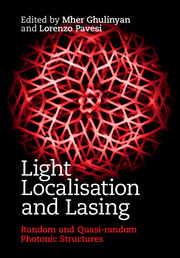Book contents
- Frontmatter
- Contents
- List of contributors
- Preface
- 1 Light propagation and emission in complex photonic media
- 2 Transport of localized waves via modes and channels
- 3 Modes structure and interaction in random lasers
- 4 Ordered and disordered light transport in coupled microring resonators
- 5 One-dimensional photonic quasicrystals
- 6 2D pseudo-random and deterministic aperiodic lasers
- 7 Three-dimensional photonic quasicrystals and deterministic aperiodic structures
- 8 Cavity quantum electrodynamics with three-dimensional photonic band gap crystals
- References
- Index
4 - Ordered and disordered light transport in coupled microring resonators
Published online by Cambridge University Press: 18 December 2014
- Frontmatter
- Contents
- List of contributors
- Preface
- 1 Light propagation and emission in complex photonic media
- 2 Transport of localized waves via modes and channels
- 3 Modes structure and interaction in random lasers
- 4 Ordered and disordered light transport in coupled microring resonators
- 5 One-dimensional photonic quasicrystals
- 6 2D pseudo-random and deterministic aperiodic lasers
- 7 Three-dimensional photonic quasicrystals and deterministic aperiodic structures
- 8 Cavity quantum electrodynamics with three-dimensional photonic band gap crystals
- References
- Index
Summary
Introduction
Optical waveguides are used to transport both phase-insensitive and phase-sensitive information in today's communications networks and signal processing devices. Among applications needing high performance waveguides are delay lines and optical phase-locked loops, generating precise phase offsets for waveform sampling, analog-to-digital conversion, and beam-forming. In fundamental terms, high performance waveguides are based on the ballistic propagation of photons [4, 168], which may be capable of reaching the ultimate limits of computational speed and energy efficiency of interconnects [331, 332], since ballistic propagation of electrons [132] is difficult to achieve in practical chips. Therefore, quantifying the impact of disorder on light propagation, and distinguishing between ballistic and non-ballistic transport, is an important and ongoing research endeavor.
Ballistic transport requires that the phase-breaking length be greater than the device length; which is usually satisfied in optical fibers of short length, and in planar glass lightwave circuits, in which the refractive index difference between core and cladding materials is small [260, 261]. But light propagation in high-index contrast waveguides, e.g. in silicon photonics, can be highly susceptible to the effects of disorder. Here, we will focus on periodically structured nanophotonic waveguides, e.g. coupled microring resonators [188, 392, 548, 555] in which light can accumulate significantly more phase and delay per unit length than in conventional waveguides. Such devices can be valuable for many reasons, among which are the facts that on-chip footprint is a precious commodity in real-world devices, and that our ability to increase, via geometrical patterning of waveguiding structures, the optical phase accumulation per unit (structural) length will considerably benefit nonlinear multiwave interactions. However, such devices may also be more strongly susceptible to the effects of disorder [329], and the issue of whether ballistic propagation can be achieved in coupled-resonator structures is being investigated closely.
From a physics viewpoint, one-dimensional structures are interesting because multiple scattering in transverse dimensions can be restricted, e.g. by using single-transverse-mode waveguides as the constituent building blocks for linear chains of resonators, e.g. microring arrays.
- Type
- Chapter
- Information
- Light Localisation and LasingRandom and Pseudo-random Photonic Structures, pp. 80 - 98Publisher: Cambridge University PressPrint publication year: 2014

